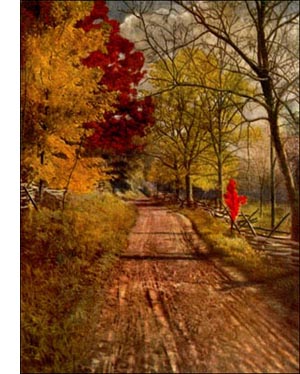Seaside Alder Tree
 Seaside Alder (Alnus maritima, Nutt.)-A round-topped tree 15 to 30 feet, with slender branches. Bark thin, smooth, light brown; twigs greyish. Wood soft, light brown, close grained. Buds acute, dark red, 4 inch long, with silky pubescence. Leaves 3 to 4 inches long, oblong, ovate or obovate, acute at both ends, shining dark green above, pale green and dull beneath, edges set with fine incurving teeth; petioles short. Flowers autumnal, from buds of previous spring; monoecious; staminate catkins, golden, 1 to 2 inches long; pistillate, oblong, 1/8 inch long, with red tips of stigmas protruding from scales. Fruit, a woody, oval strobile, ripe a year after blooming; scales thick, shiny, each bears two flat, obovate, pointed nuts or seeds. Preferred habitat, borders of streams and ponds, near, but not actually on, seacoast. Distribution, eastern Delaware and Maryland, Indian Territory. Uses: Rarely planted, but deserving of cultivation for its glossy foliage and the beauty and unusualness of its golden catkins, appearing in September.
Seaside Alder (Alnus maritima, Nutt.)-A round-topped tree 15 to 30 feet, with slender branches. Bark thin, smooth, light brown; twigs greyish. Wood soft, light brown, close grained. Buds acute, dark red, 4 inch long, with silky pubescence. Leaves 3 to 4 inches long, oblong, ovate or obovate, acute at both ends, shining dark green above, pale green and dull beneath, edges set with fine incurving teeth; petioles short. Flowers autumnal, from buds of previous spring; monoecious; staminate catkins, golden, 1 to 2 inches long; pistillate, oblong, 1/8 inch long, with red tips of stigmas protruding from scales. Fruit, a woody, oval strobile, ripe a year after blooming; scales thick, shiny, each bears two flat, obovate, pointed nuts or seeds. Preferred habitat, borders of streams and ponds, near, but not actually on, seacoast. Distribution, eastern Delaware and Maryland, Indian Territory. Uses: Rarely planted, but deserving of cultivation for its glossy foliage and the beauty and unusualness of its golden catkins, appearing in September.The seaside alder divides with the witch hazel the distinction of bearing flowers and ripening fruit simultaneously in the fall of the year. They do not compete for popular favour, because the alder comes first, hanging out its golden catkins in clusters on the ends of the season's shoots in August and September. Nothing is left of them when the witch hazel scatters its dainty stars along the twigs in October and November. The tiny pistillate cones of the alder are scarcely larger than the buds that keep them company.
The seaside alder grows well in the Arnold Arboretum, at Boston, flowering profusely, thus proving itself hardy in New England, and comfortable in dryer soil than it naturally chooses. It is quite worthy of the attention of those who seek for beauty and novelty of habit among little native trees.